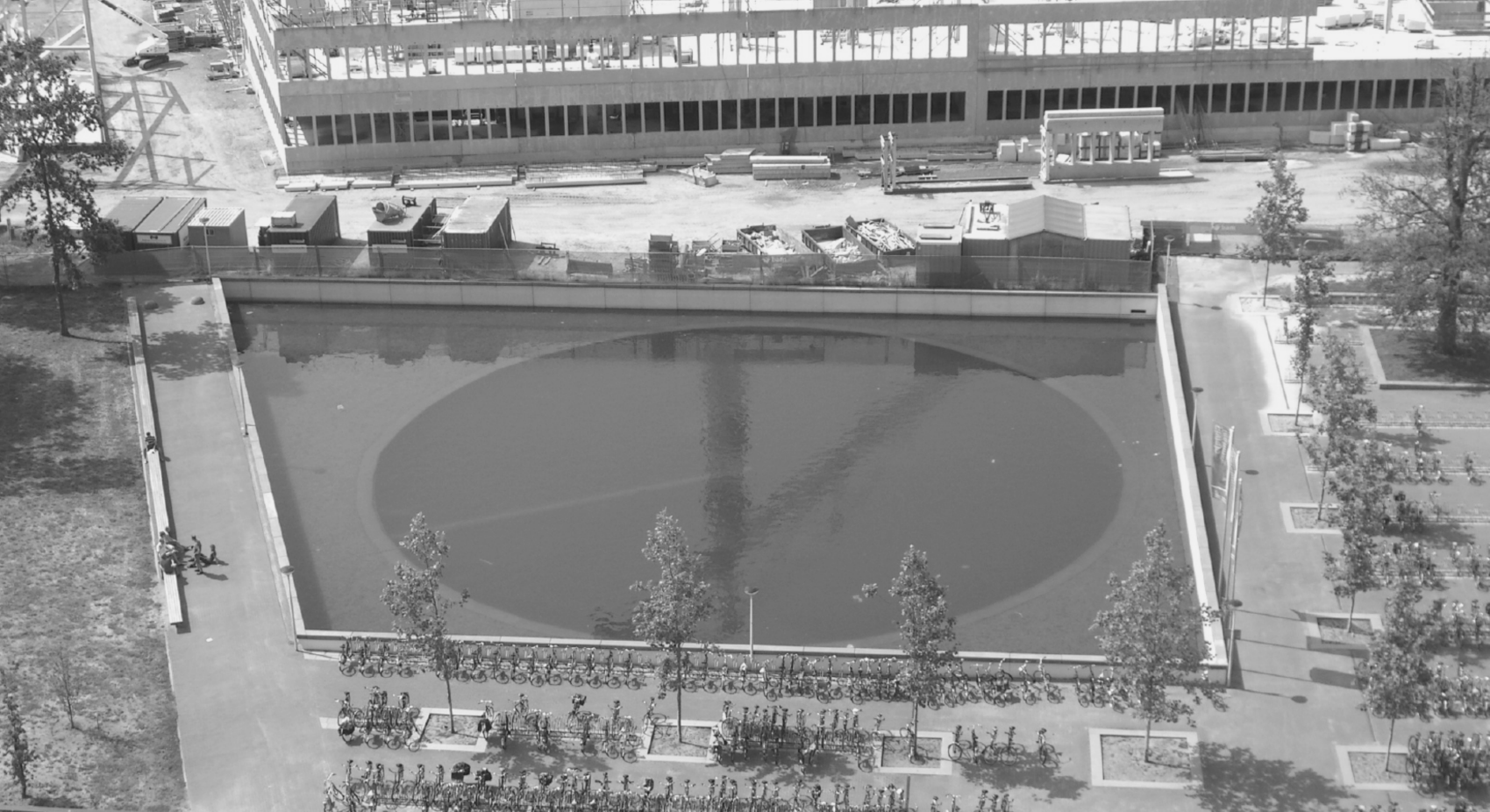3.8 Energy-Saving Technologies in the Built Environment
3.8.1 Design and Energy Use in the Built Environment
In the European Union, the energy use of the built environment is believed to be more than 40% of the total energy use (EC, 2002). Due to multiple negative environmental effects of this energy use, reducing energy use and making use of renewable energy sources receive a lot of attention. In many countries the energy use of buildings is being reduced through construction regulations. As well as that, the energy performance of buildings is made transparent by energy labels.
It is in this context that this section gives an overview of energy-saving technologies that have been, are being, or presumably will be adopted in the built environment. First the role of energy consumption will be elaborated on by giving a framework for particular energy-saving technologies.
The science involved in the energy use of buildings, ranging from houses to offices and from libraries to hospitals, is building physics. The provision of a certain level of human comfort forms the basis for building physics and for building-related energy use. Users of buildings – for example, residents and employees – want to feel comfortable in a building that gives them shelter from the outdoor climate. Therefore, it is necessary to provide them light, ventilation, low levels of noise, a certain indoor temperature, and humidity. In this section, the focus will be on the constructional and system technologies that help to provide and maintain a comfortable indoor temperature against relatively low environmental costs. Although also much electric energy is used in buildings, the focus in this section is in that regard on thermal energy. For specific information about electrical energy, we refer to the other sections of this chapter and the other chapters of this book.
To come to the adoption of energy-saving technologies in the built environment, a three-step design principle, called Trias Energetica, can be used (Entrop and Brouwers, 2010). The Trias Energetica states the following:
This three-step principle has already been known for many years among many Dutch architects, principals, project developers, and construction engineers. Application of the principle is indirectly enforced by the Building Code, which demands that buildings have a minimum level of insulation, a minimum ventilation rate, a maximum infiltration rate, and a minimum energy performance (Entrop, Brouwers, and Reinders, 2010). A dedicated collection of construction technologies and system technologies needs to be applied to a building design in order to meet this energy performance. In this sense, in this section various technologies are explained.
In Section 3.8.2 different construction technologies – often reflecting on the structure and building envelope of buildings – will be explained. In Section 3.8.2 system technologies – often reflected in the interior of buildings – are presented. Besides these construction and system technologies, also some other technologies exist to reduce the energy use of the built environment. These technologies exceeding the envelope of a building are mentioned in Section 3.8.2 and are, in this section, addressed as transcendental technologies.
3.8.2 Construction Technologies
Construction technologies form a category of energy-saving technologies that is strongly related to the building envelope. These technologies reflect the structure and the shell of buildings. When there is no match between outdoor temperatures and indoor temperatures that is regarded as comfortable, the structure of this shell needs preferably to offer some resistance to heat transfer. The basic principles by which heat can be transferred are as follows:
Heat Transmission
Buildings are constructed to provide shelter. Land plots in different areas are subject to different climates. When solar irradiation is high and outdoor temperatures are high, one expects a building to offer shading and relatively low temperatures. When wind speeds are high and outdoor temperatures are low, one expects a building to offer relatively high temperatures and protection from the wind. The need to convert fossil fuels (or other sources) in heat depends on how well a building can keep the heat inside. In a warm climate, it is important to keep the heat outside. The heat transmission through the building shell depends on its heat resistance, R (m2 K/W). This heat resistance is the reciprocal of the overall thermal transmittance through a particular part of a construction, U (W/m2 K).
Often the shell consists of multiple layers of materials. A wall, for example (see Table 3.8.1 and Figure 3.8.1), can consist of sand–lime bricks (100 mm), insulation (120 mm), cavity (40 mm), and bricks (100 mm). The total heat resistance Rtotal is determined by the thermal conductivities represented by λ in (W/m K) over the thickness of these individual materials, the heat resistance at the surfaces of the materials, and the heat resistance of the airspace.
(3.8.1)![]()
Table 3.8.1 The cross-section of a wall and its thermal resistance.
| Thickness | Thermal transmittance or resistivity | |
| Rsi internal surface | — | 0.13 m2·K/W |
| R1 plaster | 2 mm | ±0.45 W/m·K |
| R2 sand–lime blocks | 100 mm | ±1.15 W/m·K |
| R3 insulation | 120 mm | ±0.04 W/m·K |
| Rcavity cavity | 40 mm | 0.18 m2·K/W |
| R4 brickwork | 100 mm | ±0.85 W/m·K |
| Rse external surface | — | 0.04 m2·K/W |
Figure 3.8.1 The cross-section of a wall and its thermal resistance
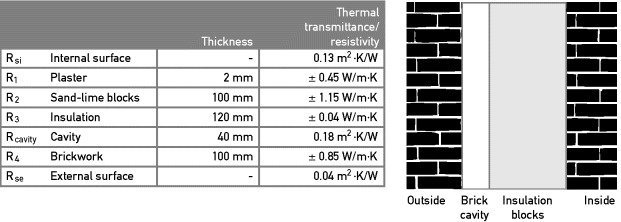
Where:
R1...x = heat resistance of a certain uniform construction material (m2 K/W);
Rsi = heat resistance at the internal surface of a construction (m2 K/W);1
Rcavity = heat resistance inside an air cavity in a construction (m2 K/W);2
Rse = heat resistance at the external surface of a construction (m2 K/W);3
l = length or thickness of the material (m); and
λ = thermal conductivity of the uniform material (W/m K).
In the Netherlands, a minimum heat resistance Rtotal–Rsi–Rse of the construction materials (including air cavity) of 2.5 m2 K/W is compulsory, but in new dwellings heat resistances of 3.5–5.0 m2 K/W are already often achieved. When constructing passive houses (with a low annual energy use of 15 kWh/m2 at maximum) in a moderate climate, a heat resistance Rtotal of 10 m2 K/W or more is needed.
Increasing the thickness of insulation materials (see Figure 3.8.2) is one way to improve thermal resistance. Passive houses make use of insulation packages with a thickness of up to 400 mm. However, the distance between internal and external brickwork needs to be carefully considered in these cases. When the distance is that large, losses occur regarding strength and stability. New insulation materials, based on the aerospace industry, have been introduced that focus on not only blocking thermal conduction but also blocking radiation. These insulation materials consist of multiple layers of synthetic or metal foils. Although some debate exists regarding the effectiveness of these products, one can imagine that it is important to reflect on blocking both thermal conduction and radiation.
Figure 3.8.2 Roof construction of a house built in 1982 with only 30 mm of insulation under the roof tiles
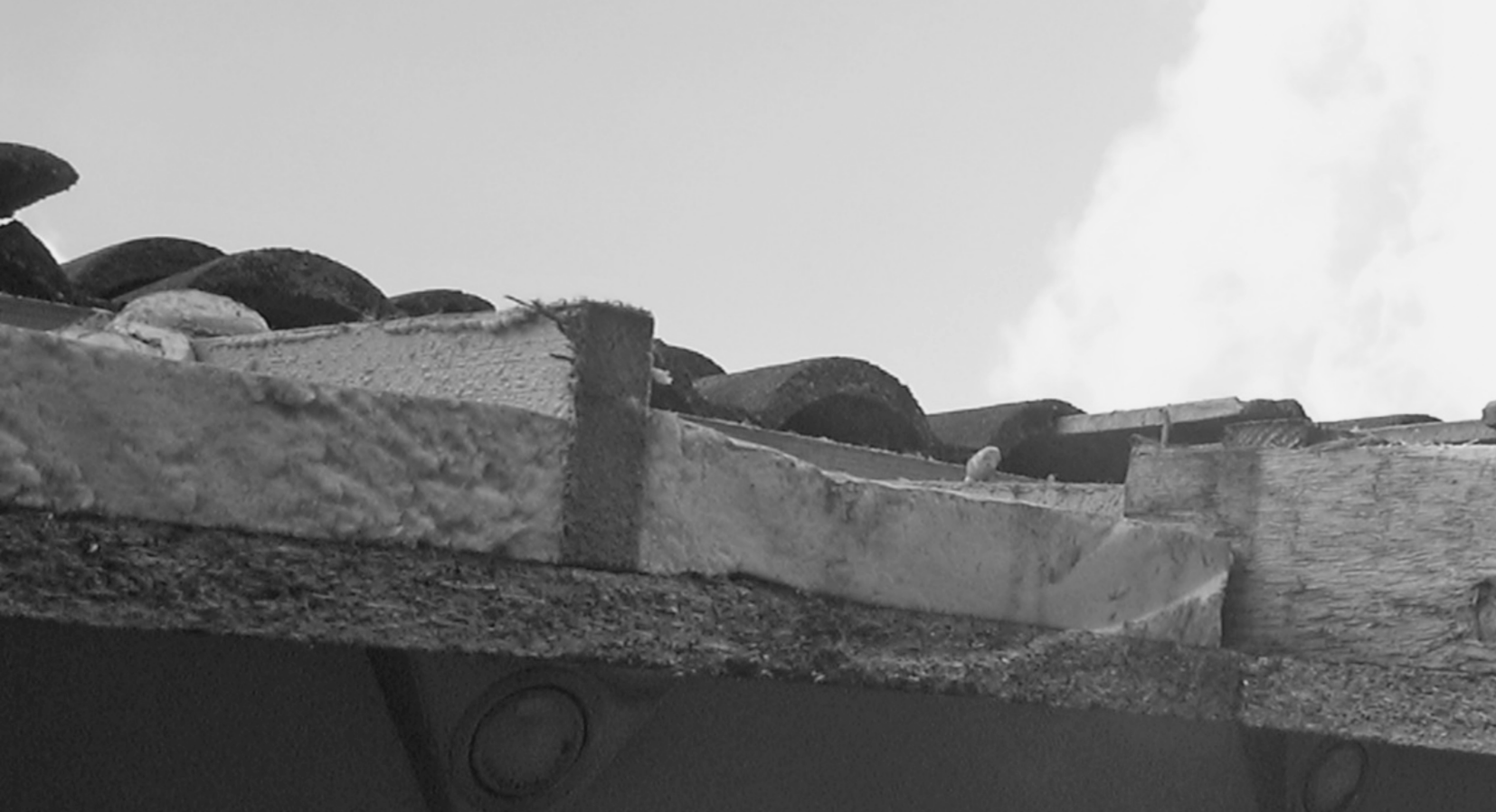
Air Tightness
A well-insulated building cannot reach maximum energy efficiency without addressing its air tightness. Different construction components – for example, walls, roofs, doors, and window frames – need a tight fit that disables heat transfer by air through gaps and cracks. The proper term for this aspect in designing construction is infiltration. Current infiltration rates are significantly reduced by paying much attention to construction details on the connections between different building components. Heat losses due to infiltration are being reduced by applying door frames and windows frames with double rubber sealing. The connections between walls and these frames or between the walls and roof are made airtight by using, for example, expanded polyurethane and sealant. The infiltration is often expressed in m3/h m2, often measured at a standard pressure difference of 50 Pa between inside and outside the building. Of course, the final heat losses due to infiltration also depend on the temperature difference between the air inside and outside the building.
Solar Transmittance
Transparent surfaces in the building shell make it possible for solar irradiation to directly enter the building. In this case not only is the mentioned thermal transmittance U (W/m2 K) or heat resistance R (m2 K/W) an important aspect, but so also is the level of solar transmittance, expressed by a so-called g-value (−), and visible light transmittance, expressed by a VLT value (−). All three variables can be used to design windows that fit the future use of a building (see Table 3.8.2). In an office building in a moderate climate, the internal heat load requests windows that keep as much solar irradiation out as possible during daytime. In houses one can benefit from heat due to solar irradiation during approximately three seasons per year. On hot summer days, shading helps preventing internal overheating. The application of shadings responding automatically to the weather conditions is especially relevant when buildings are well insulated.
Table 3.8.2 Overview of some standard values of different types of glazing for dwellings (NEN, 2004)

Heat Capacity
Due to the use of concrete and brickwork, buildings are in general heavyweight constructions offering large heat capacities. Temporary buildings are often lightweight constructions. Well known in this category are caravans and so-called portacabins, in which indoor temperatures can rise significantly during hot summer days. A high sensible heat capacity can be used to store heat due to solar irradiation during daytime and to lose heat during relatively cold nights.
Phase Change Materials
The latent heat capacity of a material is in general much larger than the sensible heat capacity. In the case of water, the sensible heat capacity is 4.2 kJ/(kg·K). The latent heat capacity is 334 kJ/kg in the case of solidification and 2260 kJ/kg in the case of vaporization (Verkerk et al., 1992). The liquefaction of ice or evaporation of water for cooling purposes both form ancient techniques, but phase change materials (PCMs) with transition temperatures for specific purposes were introduced in the nineteenth century (Kürklü, 1998).
Multiple materials are offered that already have a melting temperature of around 18–23°C (Zalba et al., 2003; Baetens, Jelle, and Gustavsen, 2010), which can be considered to be around comfortable indoor temperatures. It is shown that PCMs can help reduce energy use for maintaining a comfortable indoor temperature (Entrop, Brouwers, and Reinders, 2011; Huang, Eames, and Hewitt, 2006; Sharma et al., 2009; Zalba et al., 2003), since they have the ability to store and release both sensible and latent heat. An ambient temperature below the transition temperature will ascertain that the latent heat in PCMs will be or is emitted to the surroundings. When the ambient temperature rises, the thermal energy necessary for liquefaction will be provided by the surroundings. PCMs will act as a thermal battery storing thermal energy and reducing the need for fossil fuels. Inside a construction they can reduce maximum peak temperatures and increase minimum temperatures by storing in a passive way thermal energy derived from solar irradiation (Entrop, Brouwers, and Reinders, 2011).
Green Roofs
The fact that the latent heat capacity of water is high is also a big advantage in using green roofs. Green roofs consist of a thin earth package or another substrate with vegetation (often sedum; see Figure 3.8.3). Rainwater in these roofs will partially evaporate during hot summer days, which can result in lower indoor temperatures. The substrate and vegetation will also improve the roof's heat resistance in general. Another big advantage is that after precipitation, the ru off to water streams or water treatment facilities will show smaller peaks when large surfaces of green roofs are applied.
Figure 3.8.3 Sedums in a green roof
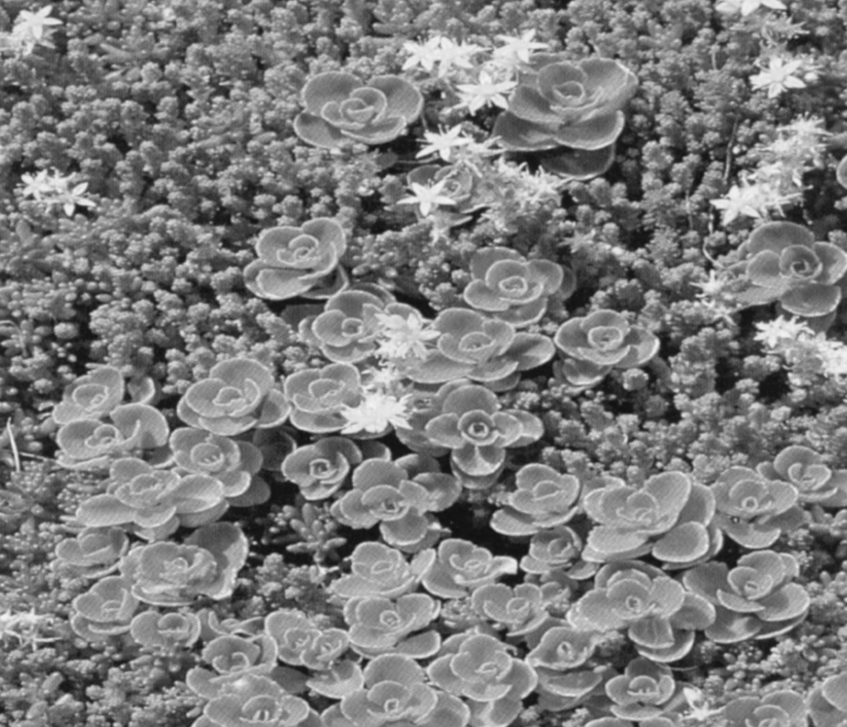
3.8.3 System Technologies
The multiple varieties of components making up the building shell have been addressed. In this section, the systems are explained that can provide energy to and withdraw energy from buildings. Often these systems are referred to by the term heating, ventilating, and air conditioning (HVAC). The need for thermal energy depends on climate conditions during a specific season, building characteristics, and personal behavior. The need for ventilation is related to the activities conducted in a room or building, the number of people present, building characteristics, and personal behavior. Electric energy is needed for light, mechanical work, or electronic systems.
Ventilation Systems
Humans need oxygen, which is provided by means of fresh air preferably with a humidity of 40–70%. The task of a ventilation system is to provide enough fresh air to a building so the people within it can do their activities (e.g., working, sporting, cooking, or sleeping). Two basic principles can be distinguished in ventilating buildings, namely, natural and mechanical ventilation. These two principles are used in generating an incoming (fresh) and outgoing (stale) airstream. During winter in a moderate climate, the outgoing stale air means a loss of thermal energy. By applying heat recovery systems in the ventilation system, thermal energy from the outgoing stale air is passed over (by means of conduction) to the incoming fresh airstream, without mixing the two airstreams. The advantage of mechanical ventilation compared to natural ventilation systems is the former's better controllability and reliability, and the possibility to apply heat recovery. The disadvantage is, of course, the use of electric energy for the fan and control system.
Heating Systems
Thermal energy needed to offer comfortable living or working space in buildings is often provided by burning fossil fuels. In the Netherlands, natural gas is commonly used for heating buildings, cooking, and heating tap water. In the largest part of the world biomass, in the form of wood, is used for heating and cooking. Heating technologies focusing on energy saving try to make more efficient use of fossil fuels or try to make use of renewable sources. Highly efficient boiler systems, micro-cogeneration heat and power systems, heat pumps, and integral hybrid forms of heat generation will be addressed.
Highly efficient boiler systems, based on the principle of burning fossil fuels, are able to use the heat directly provided by incinerating a specific fossil fuel and the heat indirectly provided by flue gasses originating from the incineration. Based on the lower caloric value of the specific fossil fuel, such as natural gas, the efficiency of these systems can exceed 100%. To a lay observer, this suggests that energy is being created. Nevertheless, when the efficiency is calculated making use of the upper caloric value of the fossil fuel, the efficiency will be below 100%.
The consideration that burning fossil fuels on high temperatures to come to a low indoor temperature of only 20°C, resulted in a search for better usage of these scarce resources. The concept of exergy, expressing the potential to perform mechanical work, gave the insight that it would be wishful to integrate the production of electric energy. On a large scale, electric power plants, which make use of natural gas, coal, or nuclear power, can distribute their so-called waste heat to nearby buildings. In many cities district heating, using natural gas or biomass for example, provides electric energy and thermal energy to the neighborhood (i.e., at the meso scale). The smallest in line forms the micro-cogeneration heat and power system (μ-CHP). These systems, using natural gas, can produce some electric energy while providing heat to a single household. For small offices or industrial buildings, mini-CHP systems exist that are also able to make use of wood as a fuel.
By applying the same principle of a refrigerator, a heat pump is able to transport heat from the surroundings into a building or vice versa (see Figure 3.8.4). The thermal energy can be provided by ground, groundwater, open water, or air. Their low-temperature heat is able to evaporate the low-pressurized working fluid. After compressing the gas, it becomes fluid in the condenser, where the thermal energy is used for the building's heating system. The working fluid will pass a valve before entering the evaporator again. In this cycle, mechanical work is executed by the compressor that needs electric energy or natural gas.
Figure 3.8.4 Representation of the heat pump or refrigeration cycle in which a working fluid is being evaporated and condensed to enable the transport of heat
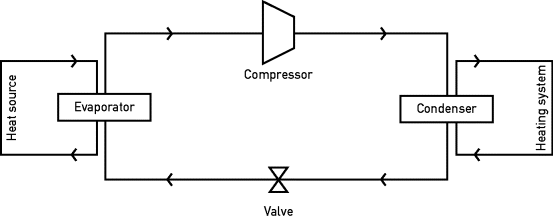
Depending on the regional climate and the direct surroundings around a building, certain heating systems can have advantages and disadvantages. Therefore, there exists a large group of hybrid systems, in which multiple systems collaborate in providing heat efficiently for space heating and even tap water. For space heating, a water temperature above 25°C can already be sufficient, but heating tap water demands a higher temperature of at least 60°C at the water taps. A hybrid system can, for example, be a combination of a solar collector, air source heat pump, and natural gas high-efficiency boiler. In that case, the solar collector and heat pump can be used for space heating and to heat tap water. When outdoor temperatures and solar irradiation decrease, the high-efficiency boiler can be used to increase the esyrt temperature for space heating or tap water. Section 3.8.3.3 will elaborate on more technologies to save energy when heating tap water.
Tap Water–Heating Systems
Compared to space heating, relatively high temperatures are needed for warm tap water to prevent bacteria of the species Legionella pneumophila in water pipes. In combination boilers, a temperature of 60°C or more can easily be met. A combination boiler can make use of renewable energy sources by means of a solar collector. This solar connector provides heat via a heat exchanger to a reservoir. The heat reservoir will store heat until the moment heat is needed for space heating or tap water. One speaks of a PVT panel, when a combined photovoltaic panel and thermal solar collector provide electric and thermal energy.
When heated tap water is used for showering, the waste water is 30°C, which is relatively warm. The thermal heat of this waste water can be used to directly heat cold water. A heat exchanger in the drain of the shower or directly on the floor of the shower will heat the cold water running toward the shower. When making use of a thermostatically controlled tap, some part of the heated water will be automatically replaced by the (now) slightly heated cold water. This will reduce the energy use of the boiler system.
Another way to reduce the energy use of a tap water–heating system is to minimize the distance between the heating system and the tap. Less unnecessarily heated water will stay behind in the water pipes when the tap is closed. When new houses are designed, the distance from the water boiler to bathroom and kitchen is kept as short as possible. The same accounts for the distance between the boiler system and kitchenette in new office buildings. In existing buildings, it is quite hard to reduce these pipe lengths.
Cooling Systems
The principle of the heat pump is the reverse of the principle of a refrigerator. When a heat pump is applied in buildings, the system offers the possibility to reverse the heat transport. The heat pump will be able to cool the building. An air-conditioning system makes use of the same principle. However, an air-conditioning system has to cope with the low heat capacity per cubic meter of air at the heat source and heat sink. This makes it hard to achieve high energy efficiency. A heat pump often has a heat sink in the form of a heating system using water as a medium.
Electric Systems
In Europe many countries make use of an electricity grid supplying an alternating current at 230 V at 50 Hz to households. In the United States, 115 V at 60 Hz is offered. Office buildings and small-scale industrial building often make use of high-voltage alternating current, which offers more power than the regular voltage of 230 V. In Europe, the high voltage is 400 V. However, many appliances in households need only little power, direct current, and low voltages. The number of transformers that are used for mobile telephones, computer screens, computers, game computers, and so on is increasing every year.
Comparable to the situation in which natural gas is being incinerated to offer high-temperature heat for only low-temperature tap water heating and space heating, it also seems strange to generate high-voltage electric energy for low-voltage applications. Photovoltaic systems can provide electric energy with enough power for many of the low-voltage electric appliances in use today. A promising energy-saving measure would be the introduction of a low-voltage (DC) network in houses to which these electric appliances can directly connect. The electric energy for this network can be provided by batteries charged by photovoltaic panels, windmills, or small-scale hydropower.
3.8.4 Transcendental Technologies
The built environment encompasses many different buildings with all sorts of functions. A power plant belongs to a particular category of buildings that is specifically constructed to make an energy transition possible. These power plants offer other buildings the possibility to use (high-voltage) electric energy. In analyzing energy-(saving) technologies, it is very important to conduct system analysis. What forms of energy enter and leave at which quantities? A particular system is, in this case, the object of study. The system boundaries need to be specified. Although elsewhere in this section the boundaries were laid directly around the building shell, this subsection reflects on technologies outside these boundaries. Therefore, the term transcendental technologies is used as the title here.
Landscaping
The surroundings, both natural and artificial, have a large impact on the energy use of buildings. Although it will be hard to change the local climate in favor of a lower energy use, multiple elements in the garden can work in favor of the building's internal climate. Trees offer shade in the summer and offer resistance to wind in all seasons. A pond in front of windows can act as a mirror reflecting irradiation toward the building's ceiling. A large garden or estate can provide biomass to heat living space and tap water.
District Heating
The production of electric energy and heat can take place in 1000 MW large power plants, in small 25 kW micro CHP systems, and in medium-sized CHP systems of around 50–250 MW. The last group of CHP systems often supplies heat to a city district. Therefore, the term district heating is often applied. Getting rid of heat is a necessary evil in producing electric energy. In the case of micro CHP systems and district heating, this “waste” is used in, respectively, a building and buildings to heat living space and tap water. In the case of district heating, a network of insulated pipes connects the medium-sized power plant to the buildings (see Figure 3.8.5). Offices and industrial buildings have a connection with a bigger capacity than a connection to a house. Inside the buildings only a small heat exchanger is necessary for heating tap water. The radiators can directly be fed by the heated pressurized water of the power plant or one of the intermediate heating stations. In a large network, additional boilers are needed to increase the water temperature.
Figure 3.8.5 New insulated metal pipes waiting to replace the existing pipes of a district heating system in a neighborhood in the municipality of Enschede, the Netherlands
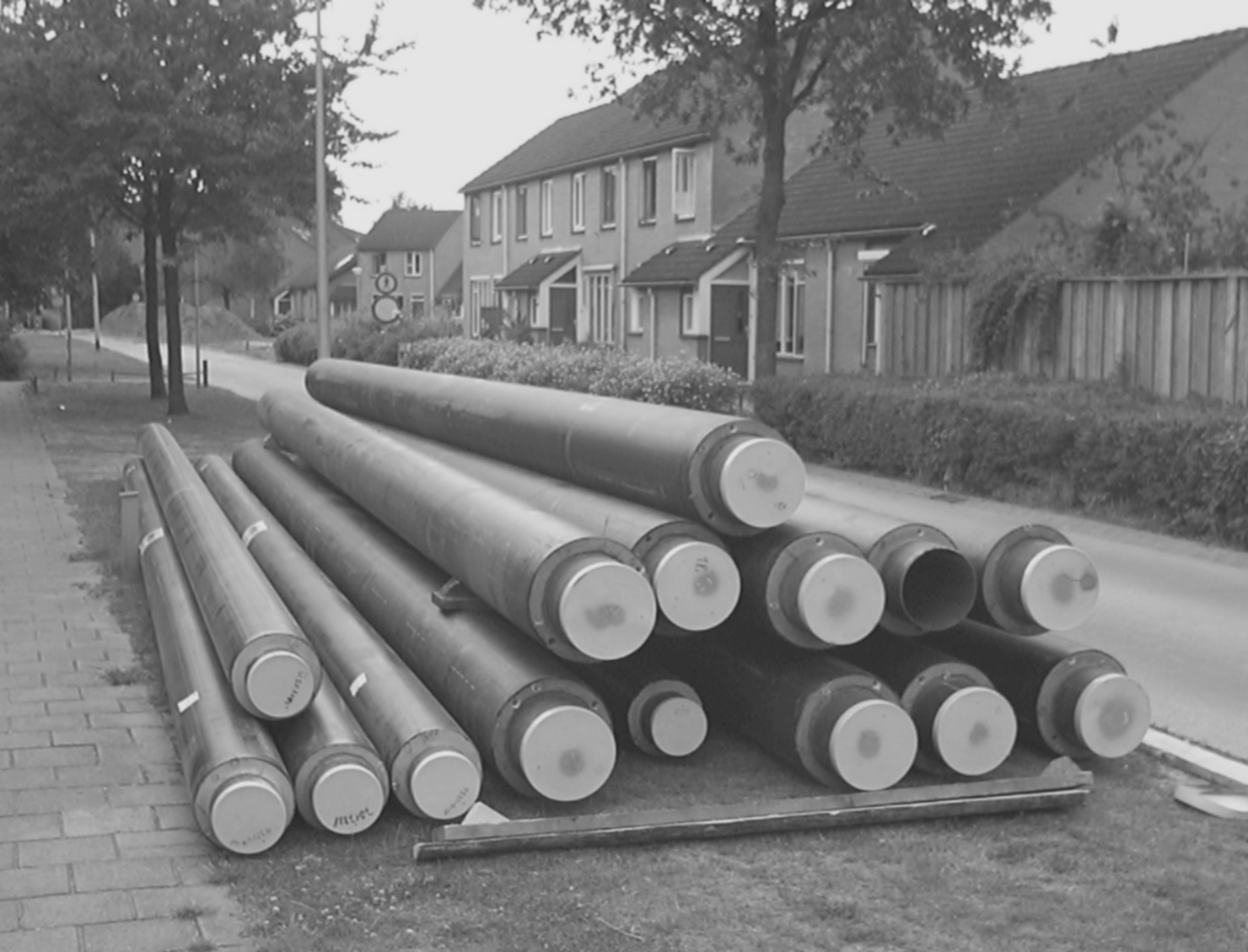
Thermal Storage
Buildings cope with two different cycles regarding ambient temperature: firstly, a short cycle of approximately 24 hours covering day and night and, secondly, a long cycle of approximately one year covering four seasons. When it is possible to store heat in a warm period during daytime and/or during summer, it can be used during a cold period in night and/or winter. A ground source heat pump is an example of a system that meks it possible to use natural seasonal thermal storage offered by the ground underneath or close to buildings.
The high thermal capacity of water makes it possible to overcome the day–night cycle. At the University of Twente, for example, an open cooling system is applied (see Figure 3.8.6). An artificial pond emits thermal energy to the atmosphere during night. In summertime the temperature of the water in the pond is even further reduced by making use of cooling overnight. During nighttime, energy prices are significantly lower than during daytime. During the day, the water of the pond is used to cool the buildings around the pond. Gradually the temperature of the water in the pond will increase before the cycle starts all over again.
Figure 3.8.6 At the University of Twente in the Netherlands, a pond is being used as a thermal reservoir to cool surrounding buildings and at the same time enable fire brigades to extinguish fires
